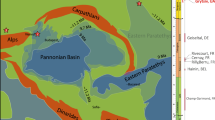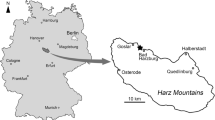Abstract
A new crown-group salamander, Kiyatriton krasnolutskii sp. nov., from the Middle Jurassic (Bathonian) Itat Formation of the Berezovsk Quarry locality in Western Siberia, Russia, is described on the basis of new material and a dentary fragment previously referred to the undescribed salamander taxon “Berezovsk salamander B” (sensu Skutschas 2013). Kiyatriton krasnolutskii sp. nov. differs from K. leshchinskiyi (type species of the genus Kiyatriton) in that the ventrolateral ridges on the atlas are sharper anteriorly, more ventrally oriented and reach the anterior cotylar rims and that the dentary has a relatively taller dental parapet. Kiyatriton krasnolutskii sp. nov. is one of the oldest salamanders in the fossil record. The finding of Kiyatriton krasnolutskii sp. nov. in Berezovsk Quarry is significant for: (1) clarifying that the previously reported “Berezovsk salamander B” is a crown-group salamander of the genus Kiyatriton; (2) extending the stratigraphic range of the genus Kiyatriton backward some 40 million years into the Bathonian, from the previously youngest record in the Aptian–Albian; (3) indicating that K. leshchinskiyi from the Aptian–Albian Shestakovo locality in Western Siberia, Russia, survived as a relic into the Early Cretaceous of present-day Western Siberia; (4) supporting the hypothesis that Bathonian vertebrate faunas of Europe and Western Siberia were homogeneous; and (5) suggesting that all Bathonian crown-group salamanders in Asia could be members of one cryptobranchoid clade and could represent the first radiation of Cryptobranchoidea.




Similar content being viewed by others
References
Averianov, A. O., & Voronkevich, A. V. (2002). A new crown-group salamander from the Early Cretaceous of Western Siberia. Russian Journal of Herpetology, 9(3), 209–214.
Averianov, A. O., Lopatin, A. V., Skutschas, P. P., Martynovich, N. V., Leshchinskiy, S. V., Rezvyi, A. S., Krasnolutskii, S. A., & Fayngerts, A. V. (2005). Discovery of Middle Jurassic mammals from Siberia. Acta Palaeontologica Polonica, 50(4), 789–797.
Averianov, A. O., Voronkevich, A. V., Leshchinskiy, S. V., & Fayngertz, A. V. (2006). A ceratopsian dinosaur Psittacosaurus sibiricus from the Early Cretaceous of West Siberia, Russia and its phylogenetic relationships. Journal of Systematic Paleontology, 4(4), 359–395.
Averianov, A. O., Martin, T., Skutschas, P. P., Rezvyi, A. S., & Bakirov, A. (2008). Amphibians from the Middle Jurassic Balabansai Svita in the Fergana Depression, Kyrgyzstan (Central Asia). Palaeontology, 51(2), 471–485.
Averianov, A. O., Lopatin, A. V., Krasnolutskii, S. A., & Ivantsov, S. V. (2010). New docodontans from the Middle Jurassic of Siberia and reanalysis of Docodonta interrelationships. Proceedings of the Zoological Institute RAS, 314(2), 121–148.
Benton, M. J., Hooker, J. J., & Cook, E. (2005). British Mesozoic fossil mammal GCR sites. In M. J. Benton, E. Cook, & J. J. Hooker (Eds.), Mesozoic and tertiary fossil mammals and birds of Great Britain, Geological conservation review series (Vol. 32, pp. 27–66). Peterborough: Joint Nature Conservation Committee.
Duméril, A. M. C. (1806). Zoologie analytique ou méthode naturelle de classification des animaux. Paris: Allais, Libraire.
Evans, S. E., & Milner, A. R. (1994). Microvertebrate faunas from the Middle Jurassic of Britain. In N. Fraser & H. D. Sues (Eds.), In the shadow of the dinosaurs: early Mesozoic tetrapods (pp. 303–321). Cambridge: Cambridge University Press.
Evans, S. E., & Waldman, M. (1996). Small reptiles and amphibians from the Middle Jurassic of Skye, Scotland. Museum of Northern Arizona Bulletin, 60, 219–226.
Evans, S. E., Milner, A. R., & Mussett, F. (1988). The earliest known salamanders (Amphibia, Caudata): a record from the Middle Jurassic of England. Geobios, 21(5), 539–552.
Evans, S. E., Barrett, P. M., Hilton, J., Butler, R. J., Jones, M., Liang, M. M., Parish, J. C., Rayfield, E. J., Sigogneau-Russell, D., & Underwood, C. J. (2006). The Middle Jurassic vertebrate assemblage of Skye, Scotland. In P. M. Barrett & S. E. Evans (Eds.), 9th International Symposium on Mesozoic Terrestrial Ecosystems and Biota, Abstracts and Proceedings Volume (pp 36–39). London: The Natural History Museum.
Gao, K.-Q., & Shubin, N. H. (2003). Earliest known crown-group salamanders. Nature, 422(6930), 424–428.
Gao, K.‐. Q., & Shubin, N. H. (2012). Late Jurassic salamandroid from western Liaoning, China. Proceedings of the National Academy of Sciences of the United States of America, 109(15), 5767–5772.
Gao, K.-Q., Chen, J., & Jia, J. (2013). Taxonomic diversity, stratigraphic range, and exceptional preservation of Juro-Cretaceous salamanders from northern China. Canadian Journal of Earth Sciences, 50(3), 255–267.
Haddoumi, H., Allain, R., Meslouh, S., Metais, G., Monbaron, M., Pons, D., Rage, J.-C., Vullo, R., Zouhri, S., & Gheerbrant, E. (2015). Guelb el Ahmar (Bathonian, Anoual Syncline, eastern Morocco): first continental flora and fauna including mammals from the Middle Jurassic of Africa. Gondwana Research. doi:10.1016/j.gr.2014.12.004.
Haeckel, E. (1866). Generelle Morphologie der Organismen. I, Allgemeine Anatomie der Organismen. Berlin: Georg Reimer.
Kielan-Jaworowska, Z., Cifelli, R. L., & Luo, Z.-X. (2004). Mammals from the age of dinosaurs: origins, evolution, and structure. New York: Columbia University Press.
Leshchinskiy, S. V., Voronkevich, A. V., Fayngertz, A. V., Maschenko, E. N., Lopatin, A. V., & Averianov, A. O. (2001). Early Cretaceous vertebrate locality Shestakovo, Western Siberia, Russia: a refugium for Jurassic relicts? Journal of Vertebrate Paleontology, 21(suppl), 73A.
Milner, A. R. (1988). The relationships and origin of living amphibians. In M. J. Benton (Ed.), The phylogeny and classification of the tetrapods, vol. 1, Amphibians, reptiles, birds (pp. 59–102). Oxford: Clarendon Press.
Milner, A. R. (2000). Mesozoic and tertiary Caudata and Albanerpetontidae. In H. Heatwole & R. L. Carroll (Eds.), Amphibian biology, vol. 4, Palaeontology (pp. 1413–1444). Chipping Norton: Surrey Beaty.
Nesov, L. A. (1988). Late Mesozoic amphibians and lizards of Soviet Middle Asia. Acta Zoologica Cracovienska, 31, 475–486.
Nesov, L. A., Fedorov, P. V., Potanov, D. O., & Golovnyeva, L. B. (1996). The structure of the skulls of caudate amphibians collected from the Jurassic of Kirgizstan and the Cretaceous of Uzbekistan. Vestnik Sankt-Petersburgiskogo Universiteta, Seriya 7, Geologiya. Geografiya, 1, 3–11 [In Russian.].
Sánchez-Hernández, B., Benton, M. J., & Naish, D. (2007). Dinosaurs and other fossil vertebrates from the Late Jurassic and Early Cretaceous of the Galve area, NE Spain. Palaeogeography, Palaeoclimatology, Palaeoecology, 249(1–2), 180–215.
Scopoli, G.A. (1777). Introductio ad historiam naturalem, sistens genera lapidum, plantarum et animalium hactenus detecta, caracteribus essentialibus donata, in tribus divisa, subinde ad leges naturae. Prague: Wolfgang Gerle.
Skutschas, P. P. (2013). Mesozoic salamanders and albanerpetontids of Middle Asia, Kazakhstan, and Siberia. In: Gardner JD, Nydam RL (eds) Mesozoic and Cenozoic lissamphibian and squamate assemblages of Laurasia. Palaeobiodiversity and Palaeoenvironments, 93(4), 441–457.
Skutschas, P. P. (2014). Kiyatriton leshchinskiyi Averianov et Voronkevich, 2001, a crown-group salamander from the Lower Cretaceous of Western Siberia, Russia. Cretaceous Research, 51, 88–94.
Skutschas, P. P. (2015). A relict stem salamander: evidence from the Early Cretaceous of Siberia. Acta Palaeontologica Polonica. doi:10.4202/app.00124.2014.
Skutschas, P. P., & Krasnolutskii, S. A. (2011). A new genus and species of basal salamanders from the Middle Jurassic of Western Siberia, Russia. Proceedings of the Zoological Institute RAS, 315(2), 167–175.
Skutschas, P., & Martin, T. (2011). Cranial anatomy of the stem salamander Kokartus honorarius (Amphibia: Caudata) from the Middle Jurassic of Kyrgyzstan. Zoological Journal of Linnean Society, 161(4), 816–838.
Sullivan, C., Wang, Y., Hone, D. W. E., Wang, Y. Q., Xu, X., & Zhang, F. (2014). The vertebrates of the Jurassic Daohugou Biota of northeastern China. Journal of Vertebrate Paleontology, 34(2), 243–280.
Wang, Y. (2000). A new salamander (Amphibia: Caudata) from the Early Cretaceous Jehol Biota. Vertebrata PalAsiatica, 38(2), 100–103 [In Chinese with English abstract.].
Wang, Y. (2004). A new Mesozoic caudate (Liaoxitriton daohugouensis sp. nov.) from Inner Mongolia, China. Chinese Science Bulletin, 49(8), 858–860.
Wang, Y., & Evans, S. E. (2006). A new short-bodied salamander from the Upper Jurassic/Lower Cretaceous of China. Acta Palaeontologica Polonica, 51(1), 127–130.
Zhang, L.-J., & Fan, G.-Q. (2001). Voldotriton [sic] sinensis sp. nov.—a new species of Mesozoic salmander [sic]. Land & Resources, 2001(2), 44–47 [In Chinese with English title.].
Zhang, P., & Wake, D. B. (2009). Higher-level salamander relationships and divergence dates inferred from complete mitochondrial genomes. Molecular Phylogenetics and Evolution, 53(2009), 492–508.
Acknowledgements
This article is dedicated to Zbyněk Roček on the occasion of his 70th birthday. My colleagues from Saint Petersburg (N. Baleeva and E. Malashichev) and I take this opportunity to thank Zbyněk Roček for his contributions to lissamphibian palaeontology and morphology and wish him good health and new discoveries. This study was supported by the Deutsche Forschungsgemeinschaft (DFG) grant MA 1643/14-1 and by Tomsk State University Competitiveness Improvement Program (2014) and the Tomsk State University Academic D.I. Mendeleev Fund Program in 2015 (grant 8.1.22.2015). For assistance in the field and/or picking the concentrate, I thank A. Averianov, I. Danilov, D. Grigoriev, O. Grigorieva, R. Hielscher, K. Jäger, J. Könen, I. Kuzmin, T. Marin, D. Rohkamp, R. Schellhorn, J. Schultz, A. Schwermann, L. Schwermann, E. Syromyatnikova and A. Valeev. I thank J. Gardner and Y. Wang for reviewing the submitted version of this paper. I also thank J. Gardner, T. Přikryl, P. Koenigshof and S. Weber for the opportunity to contribute to this special issue honoring Zbyněk Roček.
Author information
Authors and Affiliations
Corresponding author
Additional information
This article is a contribution to the special issue "Contributions in Honour of Zbyněk Roček"
This article is registered in Zoobank under urn:lsid:zoobank.org:pub:1ADC18F1-0CBE-46F1-A704-89D6C04C8EAF
Rights and permissions
About this article
Cite this article
Skutschas, P.P. A new crown-group salamander from the Middle Jurassic of Western Siberia, Russia. Palaeobio Palaeoenv 96, 41–48 (2016). https://doi.org/10.1007/s12549-015-0216-x
Received:
Revised:
Accepted:
Published:
Issue Date:
DOI: https://doi.org/10.1007/s12549-015-0216-x




